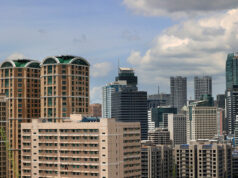Kärcher returns to clean its 3rd cultural site in PHL
AFTER THE cleanup of the Rizal Monument in Luneta Park in December 2017 and the People Power Monument along EDSA in February 2018, German cleaning equipment manufacturer Kärcher returned to Manila for the weeklong restorative cleaning of the UNESCO World Heritage Site, the San Agustin Church in Intramuros, Manila.
Two years ago, Thorsten Mowes, cleaning expert at Kärcher Inc., toured Manila and Intramuros after they cleaned the Rizal Monument.
“We had a stop here at the church, and I thought that it would also be nice to support the church with our cleaning efforts,” Mr. Mowes said during a press event on Nov. 14.
The cleanup is part of the company’s cultural sponsorship program, Kärcher Cleans the World, which was initiated in 1980 and has since cleaned more than 140 structures worldwide including the colonnades of St. Peter’s Square in Rome, the Christ the Redeemer Statue in Rio de Janeiro, and Mount Rushmore National Memorial in the United States.
Completed in 1607, the San Agustin Church is the oldest stone church in the country. Through time, it has gathered organic vegetation on its natural stone exterior.
According to San Agustin museum director Rev. Fr. Ricky Villar, OSA, the last time façade underwent intensive cleaning was six years ago when they manually scrubed its walls.
Mark Palisoc, Kärcher Philippines General Manager, told members of the press that for a Philippine site to be involved in the program, Kärcher Inc. submits a proposal to both the general headquarters in Germany and the management of the chosen site. Once the parties involved approve, an inspection of the site and testing is conducted to determine which cleaning method and device is best for the structure.
THE CLEANING PROCEDURE
Kärcher is using hot water high-pressure cleaners emitting gentle steam — the same technology it used to clean the Rizal monument. The cleaning, which will be finished tomorrow, involves Mr. Mowes and two technicians.
During his demonstration, Mr. Mowes heated the water to the maximum (150 °C) and activated the “gentle steam” setting. Then, he slowly moves the steam over the surface of a section of San Agustin’s façade five times. The difference between the cleaned and not-cleaned areas were considerable. Mr. Mowes explained that the importance of removing biological growth goes beyond the structure looking dirty. “The alga [especially lichens] can produce an acid which can destroy the stone underneath. So if it’s a layer full of biological growth, the substance behind it will be damaged afterwards. So, that’s why it’s good to remove it from time to time.”
He added that other cleaning methods such as the use of strong detergents and chemicals are not only abrasive to the surface but also bad for the environment.
For maintenance, Mr. Mowes advised stone structures to undergo cleaning every five to 10 years to avoid further biological growth. As for future projects in the Philippines, Mr. Palisoc said: “We would love to get more opportunities and more approval from our general headquarters.” — Michelle Anne P. Soliman



